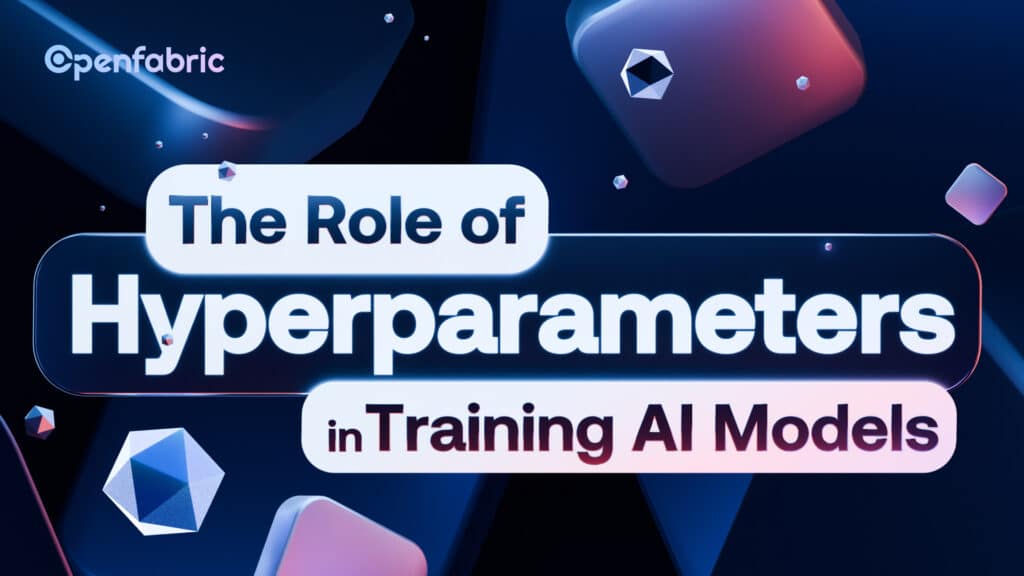
February 14, 2025 6 minutes read
The Role of Hyperparameters in Training AI Models

AI models are mainly responsible for the current transformation of industries such as marketing, finance, healthcare, and automation. As a matter of fact, we use AI models in our daily activities, for example Siri and Alexa. However, these AI agents we use are only as efficient as their training. Hence, training AI models involves the careful selection of set rules and processes that the model must follow, known as hyperparameters. Using hyperparameters in training AI models controls how the AI algorithm operates and impacts the performance of the AI model.
Hyperparameters have a direct impact on the success of an AI model. Hence, they must be highly accurate. This is because the success of the model depends on the hyperparameters used in training it. As such, the difference between a highly accurate model and one that is not equally accurate depends on the right hyperparameters. Unless the correct hyperparameters in training AI models are chosen, the AI model might not be able to function the way we want it to.
To avoid this, we will comprehensively explore hyperparameters and analyze their role in training AI models in this blog.
Let’s get started.
What are hyperparameters?
By definition, hyperparameters are external configuration variables that govern the training process of a machine learning model. We can compare them to a set of rules that the model has to follow during training. Like military training for AI models. Similarly, these variables must be optimal to ensure the proper function of the AI model. The process of selecting the optimal set of hyperparameters for a machine learning model is known as hyperparameter tuning.
It is easy to confuse “hyperparameters” with “parameters” but there’s a clear difference. AI models are autonomous regardless of these rules called hyperparameters. Because of their autonomous nature, they learn variables from the data during the training process. These variables are what is known as parameters. On the other hand, hyperparameters are not learnt autonomously. They must be manually tuned to achieve optimal results from the model. Therefore, the quality of the results of using hyperparameters in training AI models is entirely dependent on the data scientist or AI developer.
What are the categories of hyperparameters in training AI models?
Hyperparameters in training AI models are broadly grouped into two categories.
Model-related hyperparameters
These hyperparameters determine all of the AI model’s makeup and intricacies. Model-related hyperparameters are specific to the architecture and structure of a machine learning model. They define the model’s capacity to learn and how it processes data.
They vary between different model types, such as neural networks, support vector machines, and decision trees. Properly tuning these parameters is essential for building a model that balances complexity and efficiency. Examples of model-related hyperparameters include:
- Neural Networks
For training AI models, key model-related hyperparameters include the number of layers, neurons in each layer, and activation functions. Therefore, adding more layers can make a model capture more complex patterns. However, this may also increase computational cost and risk of overfitting. - Support Vector Machines (SVMs)
The important hyperparameters here are the kernel type (linear, polynomial, RBF), and the margin parameter (C). The kernel type essentially controls how the algorithm maps input data to higher dimensions. Different kernel functions work better for different data types, and selecting the wrong kernel function can lead to poor performance. Therefore, the choice of kernel to use in SVM is task and data-dependent and as such, it affects the model’s ability to separate the data.
Meanwhile, the margin parameter controls maximizing the margin and minimizing classification errors. - Decision Trees
The complexity of the tree is controlled by hyperparameters such as the maximum depth of the tree and the minimum samples required to split a node. It also helps in preventing overfitting.
Therefore, choosing the right model-related hyperparameters determines the foundational capabilities of the model.
Training-related Hyperparameters
Training-related hyperparameters control the learning process of the AI model itself. They are often universal across different machine learning models and determine how the model interacts with the data during training. Fine-tuning these hyperparameters affects how quickly a model adjusts to the training data, the stability of the learning process, and the risk of overfitting or underfitting.
A lower learning rate ensures stability but may slow down convergence, while a larger one speeds up learning but risks overshooting the optimal point. Key training-related hyperparameters include:
- Batch Size
This determines how many samples the model processes at a time before updating the weights. Smaller batch sizes offer more precise updates, while larger batches provide computational efficiency. - Number of Epochs
An epoch is the number of times the entire training dataset is passed through the model during training. Too many epochs can lead to overfitting, while too few can result in underfitting.
Therefore, properly managing these hyperparameters is crucial for achieving efficient and stable learning outcomes.
What is the role of hyperparameters in training AI models?
Hyperparameters have a direct impact on the performance of AI models. Here are some of the roles they play in training AI models.
Controlling the complexity of a model
In the training of AI models, there should be room for the accommodation of new data or parameters. A model with too many layers or neurons might memorize the existing, training data. This may lead to poor performance on new data, also known as overfitting.
On the other hand, a model with too few layers or neurons might find it difficult to learn meaningful patterns, also known as underfitting. Essentially, these patterns help the AI models in problem recognition and, subsequently, problem-solving. Using hyperparameters in training AI models helps to find the right balance to control the complexity of the model.
Optimizing learning efficiency
Hyperparameters such as learning rate and batch size determine how efficiently a model learns from data. When the learning rate is well optimized, it allows the model to achieve optimal performance faster. Therefore, the time and cost for training the model is reduced.
Enhancing generalization
As stated earlier, AI models should have room outside of their training data to accommodate other data. The right blend of hyperparameters ensures that the model is not overly specialized in the training data. Therefore, the model generalizes well and its performance is significantly improved. Also, studies show that well-optimized hyperparameters in training AI models create models that perform better than those that are not well-optimized.
Generally, using hyperparameters in training AI models allows for the adjustment of AI models to achieve optimal performance of the model.
Conclusion
We want a world where AI models are perfect. They can perfectly sort our data, create perfect healthcare plans in hospitals and optimize our travel plans and so on. To achieve this, we must leverage hyperparameters. They are key in creating the ideal AI models relevant to industries. Fortunately, with the evolution of AI and technology, optimizing AI models has become easier. As this evolution continues, hyperparameters will remain a key component in developing intelligent and functional AI systems.
However, there are various techniques for tuning hyperparameters in training AI models. We will see these techniques in our next discussion on hyperparameters in training AI models.
Visit our WEBSITE regularly to keep up with this discussion.

